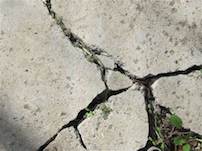 There is no doubt that concrete is strong and durable. However, if not correctly installed, it can still get cracks and damages. Cracks in your concrete don't only cause an eyesore, but it can also take from the overall value of your home. Concrete repairs are easy that is why we recommend you giving it a try. If you are looking for a DIY material to help you with the repair, the most recommended product to use is Epoxy. It is a 2-component polyurethane polymer that doesn't need routing. Epoxy is ideal for filling hairline cracks, can be applied in freezing temperatures, and is stronger than concrete; that is why it is best to use for repair. However, you have to remember that repairs can only be a temporary solution, depending on the root cause of the problem. Common Reasons for Cracked Concrete Sub-base Issue- A crack can be the result of concrete that wasn't appropriately compacted. Concrete will accumulate in one area instead of spreading evenly across the entire concrete. The concrete will eventually try to even itself out which will lead to cracks. Cold Temperatures- The cold weather brought by the winter season can be concrete's worst enemy. When the dirt accumulated under concrete freezes, it can lift the concrete and expand. The pressure coming from the expansion can then lead to cracks. Shrinking- It is natural for concrete to shrink when it dries. However, when the mixture was not cured correctly, or there was too much water, concrete will crack when it shrinks. One way to prevent concrete from cracking when it dries is by cutting expansion joints into the floor. Whatever the reason for the cracks in your concrete, repairing it can be a band-aid solution. If there is an issue with the sub-base, there may be a need to remove and redo it. If you repair the crack, it may solve the problem for a few months, but the problem will resurface after some time. A crack that is caused by the cold, you may not need to think about it until the next winter. If the problem is due to shrinkage, there may be a need for a permanent repair. How to Repair the Crack
Once you're done with the process and you are still not satisfied with the result, you may want to consider hiring a professional concrete contractor to handle the job for you. Comments are closed.
|
AuthorPittsburgh Concrete Archives
September 2019
Categories
All
|
 RSS Feed
RSS Feed